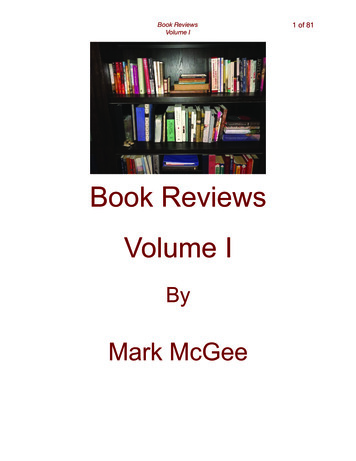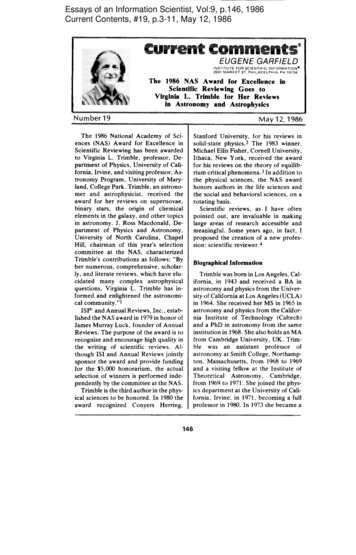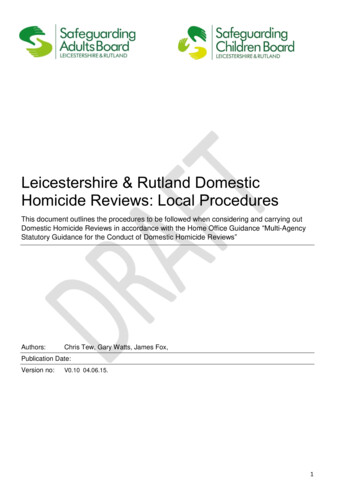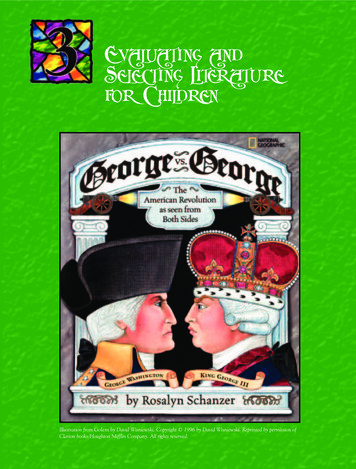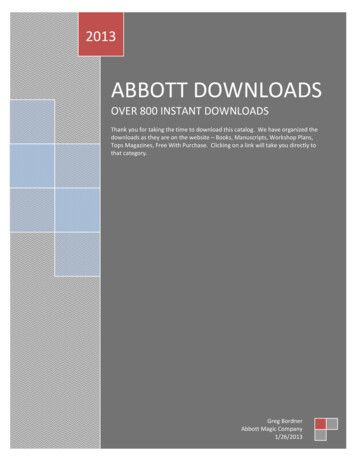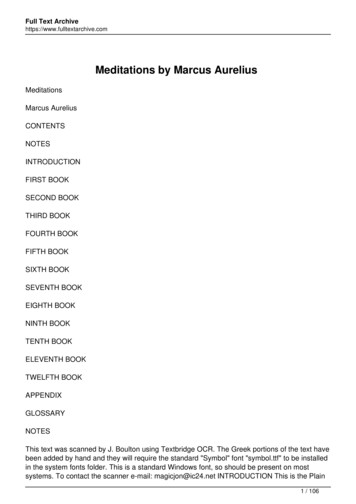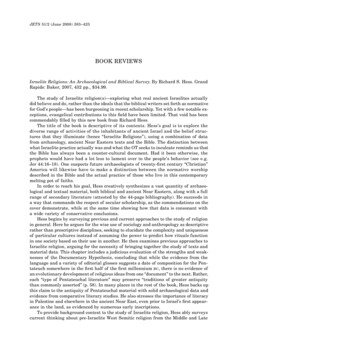
Transcription
JETS 51/2 (June 2008) 383–423BOOK REVIEWSIsraelite Religions: An Archaeological and Biblical Survey. By Richard S. Hess. GrandRapids: Baker, 2007, 432 pp., 34.99.The study of Israelite religion(s)—exploring what real ancient Israelites actuallydid believe and do, rather than the ideals that the biblical writers set forth as normativefor God’s people—has been burgeoning in recent scholarship. Yet with a few notable exceptions, evangelical contributions to this field have been limited. That void has beencommendably filled by this new book from Richard Hess.The title of the book is descriptive of its contents. Hess’s goal is to explore thediverse range of activities of the inhabitants of ancient Israel and the belief structures that they illuminate (hence “Israelite Religions”), using a combination of datafrom archaeology, ancient Near Eastern texts and the Bible. The distinction betweenwhat Israelite practice actually was and what the OT seeks to inculcate reminds us thatthe Bible has always been a counter-cultural document. Had it been otherwise, theprophets would have had a lot less to lament over in the people’s behavior (see e.g.Jer 44:16–18). One suspects future archaeologists of twenty-first century “Christian”America will likewise have to make a distinction between the normative worshipdescribed in the Bible and the actual practice of those who live in this contemporarymelting pot of faiths.In order to reach his goal, Hess creatively synthesizes a vast quantity of archaeological and textual material, both biblical and ancient Near Eastern, along with a fullrange of secondary literature (attested by the 44-page bibliography). He succeeds ina way that commands the respect of secular scholarship, as the commendations on thecover demonstrate, while at the same time showing how that data is consonant witha wide variety of conservative conclusions.Hess begins by surveying previous and current approaches to the study of religionin general. Here he argues for the wise use of sociology and anthropology as descriptiverather than prescriptive disciplines, seeking to elucidate the complexity and uniquenessof particular cultures instead of assuming the power to predict how rituals functionin one society based on their use in another. He then examines previous approaches toIsraelite religion, arguing for the necessity of bringing together the study of texts andmaterial data. This chapter includes a judicious evaluation of the strengths and weaknesses of the Documentary Hypothesis, concluding that while the evidence from thelanguage and a variety of editorial glosses suggests a date of composition for the Pentateuch somewhere in the first half of the first millennium bc, there is no evidence ofan evolutionary development of religious ideas from one “document” to the next. Rather,each “type of Pentateuchal literature” may preserve “traditions of greater antiquitythan commonly asserted” (p. 58). In many places in the rest of the book, Hess backs upthis claim to the antiquity of Pentateuchal material with solid archaeological data andevidence from comparative literary studies. He also stresses the importance of literacyin Palestine and elsewhere in the ancient Near East, even prior to Israel’s first appearance in the land, as evidenced by numerous early inscriptions.To provide background context to the study of Israelite religion, Hess ably surveyscurrent thinking about pre-Israelite West Semitic religion from the Middle and Late
384journal of the evangelical theological society51/2Bronze ages, especially as it is described in texts discovered at Mari, Ugarit, Egypt, andEmar. He concludes that the West Semitic city of Emar forms a particularly closeparallel with Israelite society, a parallel he illustrates with reference to several ritualtexts from that location. He argues the parallels between the texts from Emar andritual texts of the Bible, especially Leviticus, cast doubt on “assumptions about the relatively late dating of these biblical texts,” showing that “many of the religious practicescontained therein possess a demonstrable tradition that reaches back before the formation of Israel and into the Bronze Age” (p. 122). Hess also explores the relevant archaeological data from pre-Israelite Bronze Age sites in Palestine and Jordan to builda picture of the religious environment into which Israel emerged.Having sketched out the comparative background, Hess proceeds to deal with thereligious practices of Israel itself. His approach is developed along the two parallel tracksof text and material culture, demonstrating his ready facility with both. He illuminatesthe archaeological data with numerous photographs, many of them his own. In consecutive chapters, Hess explores the texts and material culture that are relevant to thenarrative and legal strands of the Pentateuch; the priestly and cultic strands of thePentateuch; the united monarchy; the divided monarchy; and exilic and post-exilicreligion. Of these periods, the exilic and post-exilic eras receive comparatively brief discussion, being allocated a mere ten pages. However, given the virtuosity and scope ofthe other material, it would be unreasonable to complain at this neglect, which leavesroom for others to follow in Hess’s footsteps and extend his work into this period. Theextensive bibliography is a rich treasure trove of studies across the field.At the end of his review of previous studies, Hess notes, “Perhaps the most generallyagreed upon result of the many publications within recent decades has been the sensethat the picture of religion in Israel is far more complex than had once been supposed”(p. 80). Hess certainly demonstrates the extent of that rich complexity in this book,which sometimes makes it demanding reading. Yet he also provides a sure-footed guidefor those who seek to journey through this intriguing and challenging field of study.What is more, since “Israelite religion” intersects with almost every other field of OTstudy, virtually everyone interested in the OT will find something relevant in this book.In particular, I would commend it to readers of the Journal as a model of the very bestof evangelical scholarship; Hess shows us how to engage with the academy thoughtfullyand profoundly, without adopting either a purely defensive stance or sacrificing conservative conclusions on the altar of current academic shibboleths. Would that therewere more books like this!Iain M. DuguidGrove City College, Grove City, PAReading the Bible with Giants: How 2000 Years of Biblical Interpretation Can ShedNew Light on Old Texts. By David P. Parris. London: Paternoster, 2006, 228 pp., 16.99paper.In his introduction, author David Parris clearly lays out the purposes and goals forhis book Reading the Bible with the Giants. His primary goal is to move the interpreterfrom a two-way dialogue (reader and text) to a three-way dialogue (reader, text, andthe history of biblical interpretation). The paradigm he uses to encourage this approachhe calls the “Reception Theory.” I am not certain he ever actually defines this theory,but based on his discussion, I would understand it as engaging the tradition of biblicalinterpretation we have received into our own interpretation of the biblical text. This
june 2008book reviews385method of interpretation is accomplished with a focus on three historical contexts (thethree-way dialogue): (1) the “situation into which the text was originally written andhow the original audience would have understood the text” (p. xvi); (2) the history ofinterpretation of the biblical text; and (3) how all of this history has influenced whatwe bring to the text in our own interpretation.Parris’s main concern is that we not neglect the rich history of interpretation as“recorded in the various commentaries, sermons, creeds, and confessions of the church”(p. xvii). He is not attempting to present a “one-size-fits-all” methodology. In fact, hegoes to great lengths to support and encourage the multitude of methodologies available, acknowledging the positive impact each has on the hermeneutical landscape. However, he does attempt to set forth convincingly his methodology as an integral part ofthe hermeneutical process.To accomplish his purposes and goals, Parris’s first chapter addresses the importance of understanding the author’s or the intended audience’s network of ideas andbeliefs with the goal of getting as close as possible to how the original readers wouldhave understood and experienced the text. This traditional hermeneutical focus is ananchor for his method.Chapter 2 demonstrates how the translation of words from the original languages,as well as the way words are interpreted historically, helps us understand why wetranslate words the way we do. To illustrate this, he uses the book of Jonah and theword translated “fish.” The illustration is interesting and informative; however, manymight find its thoroughness intimidating. A simpler illustration may have been moreenticing to the reader.In chapters 4 and 5, Parris demonstrates how tradition shapes our interpretationin that we are in a “living dialogue.” He encourages reading the history of interpretationwith openness and evaluation because these interpreters were set forth as leaders intheir field even though they may have arrived at interpretations different from today.As we investigate this history and formation of the Christian tradition—how it developed, dead ends, and rich exploration—we need to learn from it and advance the interpretations as they confirm, enlarge, or correct how we read the Bible. To illustratethis, the author provides a 25-page explanation of the historical interpretation of theGreat Commission. Once again, a simpler illustration would seem to be more effectiveand enticing to the average reader. His appendix to this section provides helpful adviceon the practicalities of his approach.Parris continues this practical approach in the fifth chapter by providing advice onthe three levels of reading the biblical text (devotional, literary reading, and detailedstudy). He explains how the history of interpretation in the church is to be understoodas a “hermeneutical spiral” and offers guidelines as to how to practically engage withthis history in one’s hermeneutical methodology through his “Ten Reading Strategies.”In the final chapter, Parris offers sound advice as to how to bring the ones we teachinto a greater appreciation of the rich tradition of biblical interpretation by providingan effective teaching method.In assessing this book, I had difficulty integrating the main text with (1) the informational boxes that emphasized main points; (2) the marginal readings that tookthe topic deeper; and (3) shaded summary boxes that provided additional instruction.It is a personal preference, but this trend in publishing is not helpful for me. That thebook is seemingly targeting a more average reader may be difficult for some in thatit is full of illustrations of the concepts he is trying to communicate. Consequently, inplaces it is more wordy than necessary for someone who simply desires to access thebasic information.Some may struggle with Parris’s movement away from a single “correct” interpretation of the text, which he poses as conceiving of meaning in static terms. He prefers
386journal of the evangelical theological society51/2conceiving of meaning in dynamic terms, considering many interpretations for whichwe need to make informed judgments of their appropriateness. He believes all interpretations are partial and provisional until we have a full and appropriate understandingof Scripture.Some strengths of the book include the abundance of illustrative material from thebiblical texts to demonstrate the points the author is making, even though I believetheir length may discourage the reader from engaging in similar personal study. Thebook is also very readable as Parris goes to great lengths to illustrate his concepts. Theannotated bibliography is of tremendous help to those who want to explore the topicfurther. The history of interpretation is rich for modern students of the Bible who readit with discernment, humility, and eagerness to learn. Parris wisely emphasizes thisimportant part of the hermeneutical process.David TalleyTalbot School of Theology, La Mirada, CASeized by Truth: Reading the Bible as Scripture. By Joel B. Green. Nashville: Abingdon,2007, ix 185 pp., 22.00 paper.All recent works in hermeneutics attempt to explain the roles of author, text, andreader in determining meaning. Hermeneutics textbooks by evangelical thinkers suchas Hirsch, Duvall/Hays, Fee/Stuart, Virkler/Ayayo, and Camery-Hoggatt favor authorcentered approaches, employing the methods of the modern historical-critical paradigm,and seeking first to approximate an author’s intended meaning as mediated by textualclues. Maintaining a careful separation between historical meaning and contemporarysignificance, they offer various proposals for bridging the historical gap and addressingthe modern-day reader. Although Joel B. Green repeatedly upholds the value of modernexegetical disciplines, ultimately he finds a hermeneutical approach limited to thesedisciplines to be insufficient for hearing God’s voice in Scripture. In Seized by Truth,Green affirms a more reader-oriented hermeneutic undertaken by the “Model Reader”(cf. Umberto Eco) whose theological location is within the historic and global church,the only reading community capable of reading the Bible as God-revealing Scripture.Green believes Scripture’s own aim is to shape and transform its readers in accordance with God’s purposes. Readers who “stand under” this aim must first assumea theological identity within the ecclesial community that already places itself underthe Scriptures in a posture of acceptance, devotion, attention, and trust. This postureaffirms the immediacy of the Scriptures, refusing to distance today’s Christian readerfrom the “original” audience(s). It requires that interaction with the text be guided bybeliefs in the OT as normative Christian Scripture and in Scripture’s ability to transform readers’ commitments in greater conformity to the divine purpose.A reading of the Bible as Scripture recognizes a unity of the theological disciplines—both historical and textual fields and those attending to the practice of Christian formation—and utilizes multiple resources. First, by nature of an ecclesial location, thebiblical interpreter has already been nurtured by a community that actively reads andperforms the message of Scripture. This location provides constraints and correction toparochial or egocentric interpretations and can define and discriminate between validand invalid interpretations. Second, believing interpretive neutrality to be illusory, Greenemphasizes a theologically fashioned reading that dialogues with the entire biblicalcanon and its metanarrative, the historical creeds and doctrines, and the interpreter’secclesial and theological traditions. Third, Green favors a critical engagement that is
june 2008book reviews387open to the possibility of correction from a range of interpretive communities (place,time, race, etc.). Finally, Green’s proposal is pervaded by a dependence upon the HolySpirit who generates and continues to form the believing community.Green rejects the notion of any single “correct” method for reading the Bible as Scripture. Assessing common behind the text, in the text, and in front of the text approaches,he prioritizes the text, but not to the exclusion of the history behind the text or of thetext’s readers. Nonetheless, Green relegates all methods to the service of Scripture’sown aim, and he assesses valid readings both in terms of their ability to account fortextual, historical, literary, and lexical forms, and by their ability to be ruled by a text’scanonical embeddedness within the boundaries of doctrine and to be actualized intransformed lives.Green concludes by articulating the nature of biblical authority inherent in hishermeneutical proposal. He emphasizes the Bible’s intrinsic authority that is recognized by those who are being formed and shaped by Scripture. Because the biblical narrative adequately interprets reality in light of God’s self-disclosure and graciouslyinvites readers to participate in the narrative, ultimately, the reader who recognizesScripture’s authority is one who is formed by it in accordance with God’s self-disclosure.Overall, Seized by Truth presents a strong argument that the people of God shouldnot strive for neutrality in their interaction with the Bible if it is to be formative in theirlives. Green’s positive evaluation of a reader’s self-conscious theological location withinthe Christian community, coupled with an affirmation of rigorous historical and textual work, has compelling elements, and it challenges those who either intentionallyor unwittingly denigrate theology, practice, and application to a status secondary to history and text. Nonetheless, if I as an interpreter did not already share Green’s theological presuppositions about the nature of Scripture, the arguments he presents wouldnot be compelling. Like all hermeneutical approaches intentionally located in a readingcommunity, it cannot convince the outsider of the priority of this reading communityover any other.Karelynne Gerber AyayoPalm Beach Atlantic University, West Palm Beach, FLGospel-Centered Hermeneutics: Foundations and Principles of Evangelical BiblicalInterpretation. By Graeme Goldsworthy. Downers Grove: InterVarsity, 2006, 341 pp., 29.00.Goldsworthy is a praiseworthy author of a string of books and articles on biblicaltheology, and he identifies with conservative evangelicalism, Anglicanism, Calvinism,amillennialism, and presuppositional apologetics. He is now a retired lecturer at MooreTheological College in Sydney, Australia, where he has taught hermeneutics since 1995.The title reflects Goldsworthy’s conviction that “hermeneutics focuses on the gospelas it has its outworking in the realm of our understanding of the Scriptures” (p. 16).The subtitle, however, may be partly misleading, because unlike many other hermeneutics texts, this one does not focus on general and genre-specific interpretational“principles.” Rather, it constructively criticizes hermeneutics that obscure the gospel.The body of the book has three major sections. In the first, “Evangelical Prolegomenato Hermeneutics” (pp. 21–85), Goldsworthy addresses evangelical foundations and presuppositions. One presupposition is that the Bible is God’s infallible word because itsays so (pp. 32–35). God created humans to have knowledge that is “true though finite,”not “absolute and exhaustive” (p. 35; cf. pp. 53, 55). Augustine’s epistemological stance,
388journal of the evangelical theological society51/2“I believe in order to understand,” rightly subordinates “human reason and understanding” to “divine truth and revelation” (pp. 41–42). “Non-Christian presuppositions”are “self-referentially incoherent” (p. 42; cf. 184). “The gospel is the interpretational normfor the whole Bible” as well as all reality (p. 63). Biblical theology, which “is essentiallythe examination of the individual parts to see how they fit into the big picture,” is“uniquely appropriate for” understanding “what kind of hermeneutical model fits theworld-view of Christian theism” (p. 68).The section major section, entitled “Challenges to Evangelical Hermeneutics”(pp. 87–180), selectively highlights eight significant hermeneutical errors that “eclipse”the gospel. The metaphor recognizes “that eclipses are not always total and can evenbe partial enough to pass unnoticed by all but those trained to look for them” (p. 90).Although they have many positive features, the hermeneutics of the following eightframeworks eclipse the gospel: the early church’s unwarranted allegory and typology;the medieval church’s “unbiblical philosophical categories” (p. 108); Roman Catholicism’scontradiction of justification by faith alone; liberalism’s domestication of God; philosophical hermeneutics’ proud self-subjectivity; historical criticism’s naturalistic presuppositions; literary criticism’s focus on the text and reader rather than the Author/author; and evangelicalism’s “hermeneutical perfectionism” that views their positionson key issues as infallible. Many evangelical readers will likely find the chapter onevangelicalism (pp. 167–80) to be the most interesting, insightful, convicting, and controversial. It surveys eight evangelical aberrations that approach Scripture naïvely:(1) Quietism: evangelical Docetism; (2) literalism: evangelical Zionism; (3) legalism:evangelical Judaism; (4) decisionism: evangelical Bultmannism; (5) subjectivism: evangelical Schleiermacherism; (6) “Jesus-in-my-heart-ism”: evangelical Catholicism;(7) evangelical pluralism; and (8) evangelical pragmatism.The book’s third major section, “Reconstructing Evangelical Hermeneutics” (pp. 181–313), evaluates how to reconstruct gospel-centered hermeneutics, which includes delineating the extent to which evangelicals can profitably use other hermeneuticalframeworks without compromise (p. 193). Here are four highlights: (1) Goldsworthytentatively adapts speech-act theory (pp. 215–16). (2) Preachers should utilize historybut not “set up dichotomies between the Bible as history and as literature or theology”;question the Bible’s “overall historical timeline and metanarrative”; isolate narrativedetails “from the big picture and the goal of the gospel”; or let historicity overshadowthe theological message (pp. 228, 231–33). (3) Macro-typology includes not only “facts,persons and events,” but “entire epochs or stages within salvation history.” Thus “anyperson, fact, or event in the Old Testament is a type of Christ to the degree that its theological function foreshadows that of Christ” (p. 248; cf. pp. 252–57). The hermeneuticsof Jesus and the apostles demonstrate that the OT is “all about Jesus,” but “manyChristians want to go immediately to consider how the text is about them” (pp. 251–52).Every text in the OT and NT is connected to Christ (p. 252), and “the primary application of all texts is in Christ, not in us or something else” (pp. 256–57). (4) Biblicaltheology is a key to gospel-centered hermeneutics, but it is “probably the most neglectedin all the literature on hermeneutics” (p. 258; cf. pp. 15, 312–13). Biblical and systematic theology are interrelated disciplines that should influence each other within thehermeneutical spiral (pp. 267–72). Goldsworthy concludes with a practical eleven-stephermeneutical checklist (pp. 308–13).The weaknesses in the volume are relatively minor. (1) It includes a handful oftypographical errors (e.g. pp. 36 n. 18, 202, 205) and inconsistently changes “centred”to “centered” on the cover and title page while keeping Australian spellings everywhereelse. (2) The subdivisions for some chapters are artificially parallel and could use further subdivision (e.g. chap. 2). (3) Goldsworthy relies heavily on secondary literature,especially in Part 2. (4) Sometimes he lists strings of quotations or ideas from other
june 2008book reviews389authors with little interaction or analysis. (5) By cautiously questioning the value ofstudying Jewish exegetical methods (pp. 92, 245), he does not seem to give sufficientweight to the Bible’s historical character. (6) The definitions of key terms are not alwaysclear. For example, although he quotes a variety of definitions of “hermeneutics” (p. 25),he does not clearly present his own. Another example is contrasting his references to“Krister Stendahl’s distinction between what the text meant (exegesis) and what itmeans (hermeneutics)” (p. 203), the divisions in the Interpreter’s Bible for “exegesis(what it meant)” and “exposition (what it means)” (p. 205), and “Krister Stendahl’s nowfamous distinction between ‘what it meant’ (biblical theology) and ‘what it means’ (systematics)” (p. 267). Goldsworthy appears to equate exegesis and biblical theology on theone hand and hermeneutics, exposition, and systematics on the other. My understandingis that hermeneutics refers to theoretical interpretational principles and that exegesisis the application of those principles. Goldsworthy recognizes this distinction (p. 205)but does not follow it.The book’s strengths far outweigh any weaknesses. It is Christocentric, conservatively evangelical, and fitting as an upper-level graduate textbook. The most commontheme is unmistakable: hermeneutics is based on and must center on the person andwork of Christ. Goldsworthy demonstrates the need for a robust biblical theologicalmethod that exalts Jesus, which is exactly what his book does.Andrew David NaselliTrinity Evangelical Divinity School, Deerfield, ILProphecy and Hermeneutics: Toward a New Introduction to the Prophets. By ChristopherR. Seitz. Grand Rapids: Baker, 2007, 264 pp., 16.99 paper.In biblical studies, as in all disciplines, methodological practices run the risk of outlasting the theoretical premises that engendered them. Such is the case, according toSeitz, with modern research in the prophetic literature of the OT.Prophecy and Hermeneutics uses modern introductions to the prophets as a lensinto the interpretive assumptions that govern the field. Typically, prophetic figures,ministering at particular times in Israel’s history, are provided with a socio-politicalcontext against which their individual messages can be interpreted. This creates arecord of how Israel’s religious and prophetic traditions developed over time while alsoformulating a framework by which to organize the now-composite written legacy. In sodoing, however, another context is overlooked, namely, the organization of the materialwithin the canon and the coherence created by that arrangement, a feature Seitz proposes we need to factor into current descriptions of the Prophets.Part 1 surveys the last two centuries of biblical studies, examining how reconstructions of Israel’s history eclipsed the biblical presentation of prophecy. Gerhard von Rad,perhaps the most influential and representative figure of tradition-historical methods,is the primary interlocutor.Tradition history sees the relationship between Law and Prophets in developmentalterms as the adaptation of prior traditions for a subsequent audience. It is the unfoldingtradition behind the biblical material that carries the theologically meaningful cargoand that the historian seeks to recreate. This is illustrated in Isaiah (thought to be composed at two or three different periods in Israel’s history) and the Book of the Twelve(comprised of twelve individual witnesses from the whole spectrum of Israel’s history,but joined together as one book). Both compositions are divided up, assigned to appropriate points on a historical timeline, and treated in historical sequence. According to
390journal of the evangelical theological society51/2Seitz, such reconstructions of Israel’s history dominate and ultimately obscure theexamination of the prophets, since they (1) provide a speculative organizing frameworkthat is external to the canonical presentation; (2) stop short of adequately explainingthe historical and theological significance of the final stage of the process of transmission;and (3) discount the coherent meaning of the affiliated witness reflected in the final form.Part 2 provides exegetical illustrations of a “canonical-historical” way forward, takenprimarily from the Book of the Twelve. Seitz makes perceptive observations about orderand arrangement, the juxtaposition of early and late books, and repeated concepts andphrases that appear throughout the individual witnesses of the Book of the Twelve.Examining the books in subgroupings (e.g. Haggai/Zechariah/Malachi, Amos/Obadiah,etc.), he charts a course through the material that demonstrates a thematic progressionand literary affiliation that is not merely temporal, but “figural” as well.By pointing readers to recent examinations of the Book of the Twelve as a unifiedcollection, Prophecy and Hermeneutics illustrates scholarship that is grappling with thelogic behind the final form of the material. Seitz anticipates the most common critiqueof final form approaches when he contends that the strengths of tradition history (i.e.its attention to historical reference and the distinctives of each book) need not be forfeited by attention to the final form. In fact, because canonical approaches take the finalstage in the traditioning process into account, they are, paradoxically, more historical.At the same time, this approach distinguishes itself from “literary” readings thatdepreciate the temporal indicators within the text, the historicality of the propheticfigures, and the development of traditions, by focusing attention exclusively on thefinal form.This book provides an insightful analysis of the methodological and historicalassumptions that propel current research in the Prophets. Its bold proposal promisesa fresh and exciting change of direction. This does, however, leave the reader wishingfor a clearer picture of how to proceed and more thorough illustrations of the exegeticalbenefits. Certain important methodological issues are left unaddressed, such as the relationship between the different canonical arrangements in the mt, lxx, and possiblyQumran traditions, and how Joshua–2 Kings factor into the collection of the Prophets.Finally, like the Book of the Twelve, which is the result of a long process of compositionand whose structural logic is at times difficult to decipher, this book is the amalgamationof several interwoven streams of thought, creating a narrative flow that is at timesopaque.For those of us who have greatly benefited from this and other works produced bySeitz, it is hoped that, having cleared his throat, he will undertake his own comprehensive introduction to the Prophets in accordance with the promisi
Grove City College, Grove City, PA Reading the Bible with Giants: How 2000 Years of Biblical Interpretation Can Shed New Light on Old Texts. By David P. Parris. London: Paternoster, 2006, 228 pp., 16.99 paper. In his introduction, author David Parris clearly lays out the purposes and goals for his book Reading the Bible with the Giants. His primary goal is to move the interpreter from a two .
